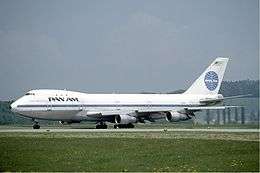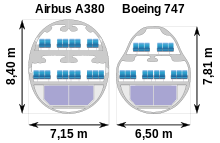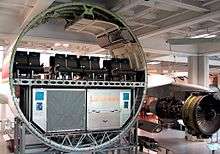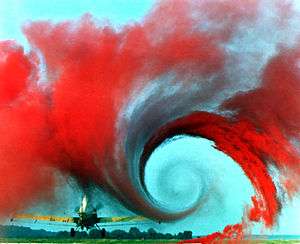Wide-body aircraft

.jpg)
A wide-body aircraft is a jet airliner having a fuselage wide enough to accommodate two passenger aisles, also known as twin-aisle aircraft, with seven or more seats abreast.[1] The typical fuselage diameter is 5 to 6 m (16 to 20 ft).[2] In the typical wide-body economy cabin, passengers are seated seven to ten abreast,[3] allowing a total capacity of 200 to 850[4] passengers. The largest wide-body aircraft are over 6 m (20 ft) wide,[5] and can accommodate up to eleven passengers abreast in high-density configurations.
By comparison, a typical narrow-body airliner has a diameter of 3 to 4 m (10 to 13 ft), with a single aisle,[1][6] and seats between two and six people abreast.[7]
Wide-body aircraft were originally designed for a combination of efficiency and passenger comfort and to increase the amount of cargo space. However, airlines quickly gave in to economic factors, and reduced the extra passenger space in order to maximize revenue and profits.[8]
Wide-body aircraft are also used for the transport of commercial freight and cargo[9] and other special uses, described further below.
The biggest wide-body aircraft are known as jumbo jets due to their very large size; examples include the Boeing 747 ("jumbo jet"), Airbus A380 ("superjumbo jet"), and upcoming Boeing 777X ("mini jumbo jet").[10][11] The phrase, "jumbo jet", derives from Jumbo, a famous circus elephant in the 19th century.[12][13]
7-abreast aircraft seats typically 160 to 260 passengers, 8-abreast 250 to 380, 9 and 10-abreast 350 to 480.[14]
History

Following the success of the Boeing 707 and Douglas DC-8 in the late 1950s and early 1960s, airlines began seeking larger aircraft to meet the rising global demand for air travel. Engineers were faced with many challenges as airlines demanded more passenger seats per aircraft, longer ranges and lower operating costs.
Early jet aircraft such as the 707 and DC-8 seated passengers along either side of a single aisle, with no more than six seats per row. Larger aircraft would have to be longer, higher (such as a double deck), or wider in order to accommodate a greater number of passenger seats. Engineers realized having two decks created difficulties in meeting emergency evacuation regulations with the technology available at that time. During the 1960s, it was also believed that supersonic airliners would succeed larger, slower planes. Thus, it was believed that most subsonic aircraft would become obsolete for passenger travel and would be eventually converted to freighters. As a result, airline manufacturers opted for a wider fuselage rather than a taller one (the 747, and eventually the DC-10 and L-1011). By adding a second aisle, the wider aircraft could accommodate as many as 10 seats across, but could also be easily converted to a freighter and carry two eight-by-eight freight pallets abreast.[15]
The engineers also opted for creating "stretched" versions of the DC-8 (61, 62 and 63 models), as well as longer versions of Boeing's 707 (-320B and 320C models) and 727 (-200 model); and Douglas' DC-9 (-30, -40, and -50 models), all of which were capable of accommodating more seats than their shorter predecessor versions. The full length double-deck solution was not realized until the twenty-first century, in the form of the Airbus A380.

The widebody age began in 1970 with the entry into service of the first widebody airliner, the four-engined, partial double-deck Boeing 747.[16] New trijet widebody aircraft soon followed, including the McDonnell Douglas DC-10 and the Lockheed L-1011 TriStar. The first widebody twinjet, the Airbus A300, entered service in 1974. This period came to be known as the "widebody wars".[17]
After the success of the early widebody aircraft, several successors came to market over the next two decades, including the Boeing 767 and 777, the Airbus A330 and A340, and the McDonnell Douglas MD-11. In the "jumbo" category, the capacity of the Boeing 747 was not surpassed until October 2007, when the Airbus A380 entered commercial service with the nickname Superjumbo.[18]
In the mid-2000s, rising oil costs in a post-9/11 climate caused airlines to look towards newer, more fuel efficient aircraft. Two such examples are the Boeing 787 Dreamliner and Airbus A350 XWB. The proposed Comac C929 and C939 may also share this new widebody market.

Design considerations
Fuselage

Although widebody aircraft have a larger frontal area (and thus greater form drag) than a narrow-body aircraft of similar capacity, they have several advantages over their narrow-body counterparts:
- Larger volume of space for passengers, giving a more open feeling to the space
- Lower ratio of surface area to volume, and thus lower drag on a per-passenger/cargo basis. The only exception to this would be with very long narrow-body aircraft, such as the Boeing 757
- Twin aisles that accelerate loading, unloading, and evacuation compared to a single aisle (widebody airliners typically have between 3.5 and 5 seats per aisle, compared to 5-6 on most narrow-body aircraft)[19]
- Reduced overall aircraft length for a given passenger or cargo capacity, improving ground maneuverability and reducing the risk of tail strikes.
- Greater under-floor freight capacity
- Better structural efficiency for larger aircraft than would be possible with a narrow-body design
British and Russian designers had proposed widebody aircraft similar in configuration to the Vickers VC10 and Douglas DC-9, but with a widebody fuselage. The British Three-Eleven project never left the drawing board, while the Russian Il-86 widebody proposal eventually gave way to a more conventional wing-mounted engine design, most likely due to the inefficiencies of mounting such large engines on the aft fuselage.
Engines

As jet engine power and reliability have increased over the last decades, most of the widebody aircraft built today have only two engines. A twinjet design is more fuel-efficient than a trijet or four-engined aircraft of similar size. The increased reliability of modern jet engines also allows aircraft to meet the ETOPS certification standard, which calculates reasonable safety margins for flights across oceans. The trijet design has been effectively dismissed due to higher maintenance and fuel costs compared to a twinjet. The vast majority of aircraft designs today have two engines, with only the heaviest widebody aircraft built with four engines (the Airbus A340, Airbus A380 and Boeing 747).[20][21]
The Boeing 777 twinjet features the largest and most powerful[22] jet engine in the world, the General Electric GE90, which is 134 inches (3.40 m) in diameter.[23] This is almost as wide as the entire fuselage of a Boeing 737 at 148 inches (3.76 m).
The massive maximum takeoff weight of the Airbus A380 (560 tonnes (1,200,000 lb)) would not have been possible without the engine technology developed for the Boeing 777 (such as contra-rotating spools).[24] The Trent 900 engine pictured, used on the Airbus A380, has a fan blade diameter of 116 inches (2.95 m), only slightly smaller than the GE90 engines on the Boeing 777. An interesting design constraint of the Trent 900 engines is that they are designed to fit into a Boeing 747-400F freighter for relatively easy transport by air cargo.[25]
Interior
The interiors of aircraft, known as the aircraft cabin, have been undergoing evolution since the first passenger aircraft. Today, between one and four classes of travel are available on wide-body aircraft.
Bar and lounge areas which were once installed on wide-body aircraft have mostly disappeared, but a few have returned in first class or business class on the Airbus A340-600,[26] Boeing 777-300ER,[27] and on the Airbus A380.[28] Emirates Airline has installed showers for first-class passengers on the A380; twenty-five minutes are allotted for use of the room, and the shower operates for a maximum of five minutes.[29][30]
Depending on how the airline configures the aircraft, the size and seat pitch of the airline seats will vary significantly.[31] For example, aircraft scheduled for shorter flights are often configured at a higher seat density than long-haul aircraft. Due to current economic pressures on the airline industry, high seating densities in the economy class cabin are likely to continue.[32]
In some of the largest single-deck widebody aircraft, such as the Boeing 777, the extra space above the cabin is utilized for crew rest areas and galley storage.
A comparison of interior cabin widths and economy class seating layouts is shown below under widebody specifications. Further information can be found under external links.
-

Cubana's Ilyushin Il-96 economy-class cabin
-
Avianca Airbus A330 business-class seats
-

First-class seats on a Cathay Pacific 747-400
Wake turbulence and separation

Aircraft are categorized by ICAO according to the wake turbulence they produce. Because wake turbulence is generally related to the weight of an aircraft, these categories are based on one of four weight categories:[33] light, medium, heavy, and super.[34]
Due to their weight, all current widebody aircraft are categorized as heavy, or in the case of the A380 in U.S. airspace, super.
The wake-turbulence category also is used to guide the separation of aircraft.[35] Super and heavy-category aircraft require greater separation behind them than those in other categories. In some countries, such as the United States, it is a requirement to suffix the aircraft's call sign with the word "heavy" (or super) when communicating with air traffic control in certain areas.
Special uses

Widebody aircraft are used in science, research, and the military. Two specially modified Boeing 747 aircraft, the Shuttle Carrier Aircraft, were used to transport the U.S. Space Shuttle. Some widebody aircraft are used as flying command posts by the military, such as the Boeing E-4, while the Boeing E-767 is used for Airborne Early Warning and Control. New military weapons are tested aboard widebodies, as in the laser weapons testing on the Boeing YAL-1. Other widebody aircraft are used as flying research stations, such as the joint German-U.S. Stratospheric Observatory for Infrared Astronomy (SOFIA). Airbus A340,[36] Airbus A380,[37] and Boeing 747[38] four-engine widebody aircraft are used to test new generations of aircraft engines in-flight. A few aircraft have also been converted for aerial firefighting, such as the DC-10-based[39] Tanker 910 and the 747-based Evergreen Supertanker.[40]
Some widebody aircraft are used as VIP transport. Canada uses the Airbus A310, while Russia uses the Ilyushin Il-96 to transport their highest leaders. Germany replaced their Airbus A310 by an Airbus A340 in spring 2011. Specially-modified Boeing 747-200s (Boeing VC-25s) are used to ferry the President of the United States. When one of these aircraft is in use by the President, its call sign is Air Force One. More information can be found under: Air transports of heads of state and government.
Comparison of wide-body aircraft civilian and military passenger and freight
| Model | production | engines | MTOW (tonnes) |
inside width | outside width | economy seats across |
|---|---|---|---|---|---|---|
| Airbus A300[41] | 1974–2007 | 2 | 171.7 | 5.28 metres (208 in) | 5.64 metres (222 in) | 8 across (17.0" wide) in 2-4-2 on TG[42] or LH[43] |
| Airbus A310[44] | 1983–1998 | 2 | 164 | 5.28 metres (208 in) | 5.64 metres (222 in) | 8 across (17.4" wide) in 2-4-2 on AI[45] |
| Airbus A330[46] | 1994- | 2 | 242 | 5.28 metres (208 in) | 5.64 metres (222 in) | 8 across (17.5" wide) in 2-4-2 on EK[47] 9 across (16.5" wide) in 3-3-3 on D7[48] |
| Airbus A340[49] | 1993–2011 | 4 | 380 | 5.28 metres (208 in) | 5.64 metres (222 in) | 8 across (17.5" wide) in 2-4-2 on EY[50] 9 across (16.5" wide) in 3-3-3 on D7[51] |
| Airbus A350 XWB[52] | 2010- | 2 | 268 | 5.61 metres (221 in) | 5.96 metres (235 in) | 9 across (18" wide) in 3-3-3 on QR[53] 8 across (19-19.5" wide)[54] 10 across in 3-4-3 proposed[54] |
| Airbus A380[55] | 2005- | 4 | 560 | 6.54 metres (257 in) upper deck : 5.80 metres (228 in) |
7.14 metres (281 in) | 10 across in 3-4-3, 17.0" wide on LH to 18.6" wide on SQ[56] 11 across (18" wide) in 3-5-3 proposed[57] |
| Boeing 747[58] | 1968- | 4 | 447.7 | 6.10 metres (240 in) | 6.50 metres (256 in) | 10 across (18.5" wide) in 3-4-3 on LH[59] |
| Boeing 767[60] | 1981- | 2 | 186.9 | 4.72 metres (186 in) | 5.03 metres (198 in) | 7 across (18.0" wide) in 2-3-2 on UA[61] 8 across (17.0" wide) in 2-4-2 on BY[62] |
| Boeing 777[63] | 1993- | 2 | 351.5 | 5.86 metres (231 in) | 6.19 metres (244 in) | 9 across (18.0" wide) in 3-3-3 on UA[64] to (18.5" wide) in 2-5-2 on AA[65] 10 across (17.5" wide) in 3-4-3 on EK[66] |
| Boeing 787 Dreamliner[67] | 2007- | 2 | 252.7 | 5.49 metres (216 in) | 5.76 metres (227 in) | 8 across (18.5" wide) in 2-4-2 on ANA[68] 9 across (17.3" wide) in 3-3-3 on UA[69] |
| Ilyushin Il-86 | 1980–1994 | 4 | 206[70] | 5.70 metres (224 in) | 6.08 metres (239 in) | 9 across (18.0" wide) in 3-3-3 on SU[71] |
| Ilyushin Il-96[72] | 1992-Halted in 2013[73] | 4 | 216 | 5.70 metres (224 in) | 6.08 metres (239 in) | 9 across (18.0" wide) in 3-3-3 on SU[74] |
| L-1011 TriStar[75] | 1972–1985 | 3 | 231.3 | 5.77 metres (227 in) | 6.02 metres (237 in) | 9 across (17.0" wide) in 3-4-2 on BA[76] or 2-5-2 on SV [77] |
| MD DC-10[78] | 1971–1989 | 3 | 259.5 | 5.69 metres (224 in) | 6.02 metres (237 in) | 8 across (20" wide) in 2-4-2[78] 9 across (18" wide) in 2-4-3[78] 10 across (16.5" wide) in 3-4-3[78] |
| MD MD-11[79] | 1990–2001 | 3 | 286 | 5.69 metres (224 in) | 6.02 metres (237 in) | 9 across (18" wide) in 2-5-2[79] 10 across (16.5" wide) in 3-4-3[79] |
See also
- Aircraft seat map
- Competition between Airbus and Boeing
- Large aircraft
- List of large aircraft
- Narrow-body aircraft
References
- 1 2 Ginger Gorham; Ginger Todd; Susan Rice (2003). A Guide to Becoming a Travel Professional. Cengage Learning. p. 40. ISBN 9781401851774.
- ↑ Paul J. C. Friedlander (1972-03-19). "the traveler's world; Test of a New Wide-Bodied Airbus". New York Times.
- ↑ Doganis, Rigas (2002). Flying Off Course: The Economics of International Airlines. Routledge. p. 170. ISBN 9780415213240.
- ↑ 27 September 2012 (2012-09-27). "Dimensions & key data | Airbus, a leading aircraft manufacturer". Airbus.com. Retrieved 2012-10-01.
- ↑ Note: See table in this article for wide-bodied passenger-aircraft fuselage widths.
- ↑ "narrowbody aircraft". Retrieved 2009-03-18.
- ↑ Royal Aero Club (Great Britain), Royal Aero Club of the United Kingdom (1967). Flight International. IPC Transport Press Ltd. p. 552.
- ↑ Eric Pace (1981-05-24). "How Airline Cabins are Being Reshaped". New York Times.
- ↑ "Wide body cargo screening still a challenge". Impact Publications. 2008-11-18. Retrieved 2009-02-17.
- ↑ "Boeing lands US$100B worth of orders for its new 777 mini-jumbo jet, its biggest combined haul ever | Financial Post". Business.financialpost.com. 2013-11-18. Retrieved 2014-04-27.
- ↑ Tina Fletcher-Hill (2011-11-23). "BBC Two - How to Build..., Series 2, A Super Jumbo Wing". Bbc.co.uk. Retrieved 2014-04-27.
- ↑ Henry Nicholls, "Jumbo the Elephant goes large", The Guardian (November 7, 2013).
- ↑ Eric Partridge, Tom Dalzell, Terry Victor, The New Partridge Dictionary of Slang and Unconventional English: J-Z (2006), p. 1128.
- ↑ Ajoy Kumar Kundu (12 April 2010). Aircraft Design. Cambridge University Press. ISBN 1139487450.
- ↑ Irving, Clive (1994). Wide Body: The Making of the Boeing 747. Coronet. ISBN 0-340-59983-9.
- ↑ Rumerman, Judy. "The Boeing 747" Archived October 7, 2012, at the Wayback Machine., U.S. Centennial of Flight Commission. Retrieved: 30 April 2006.
- ↑ "The Airbus A300". CBC News. 2001-11-12. Retrieved 2009-08-24.
- ↑ "Business | Airbus unveils 'superjumbo' jet". BBC News. 2005-01-18. Retrieved 2009-12-20.
- ↑ Bor, Robert (2003). Passenger Behaviour. Ashgate Publishing, Ltd. p. 170. ISBN 9780754609360.
- ↑ Note: As of 2008-11-30 published Airbus data, only a handful of Airbus A340-500 aircraft orders are still pending. See Airbus A340#Deliveries and
- ↑ Note: This fact can be viewed in the Specifications section; click arrows under MTOW to sort by weight.
- ↑ Eisenstein, Paul. "Biggest Jet Engine." Popular Mechanics, July 2004. Retrieved: December 2, 2008.
- ↑ "See General Electric GE90". Geae.com. Retrieved 2011-05-21.
- ↑ Guy Norris; Mark Wagner (2005). Airbus A380: superjumbo of the 21st century. Zenith Imprint. pp. 105–115. ISBN 9780760322185.
- ↑ Guy Norris; Mark Wagner (2005). Airbus A380: superjumbo of the 21st century. Zenith Imprint. p. 111. ISBN 9780760322185.
- ↑ Archived November 20, 2008, at the Wayback Machine.
- ↑ "International Business Class". Vaustralia.com.au. 2010-08-18. Retrieved 2011-05-21.
- ↑ "A380 First Class Social Area & onboard Lounge | Emirates A380 First Class | The Emirates A380 | Our Fleet | Flying with". Emirates. 2009-06-02. Retrieved 2009-12-20.
- ↑ "A380 Shower Spa | Emirates A380 First Class | The Emirates A380 | Our Fleet | Flying with". Emirates. 2009-06-02. Retrieved 2009-12-20.
- ↑ "Double luxury — how the airlines are configuring their A380s". Flightglobal.com. Retrieved 2009-12-20.
- ↑ "Airline Seat Pitch". UK-Air.net. Retrieved 2009-02-17.
- ↑ "Flying through a storm". Economist.com. 2008-10-22. Retrieved 2009-03-16.
- ↑ "EUROCONTROL — Revising wake turbulence categories to gain capacity (RECAT)". Eurocontrol.int. 2008-11-21. Retrieved 2009-12-20.
- ↑ B. N. Sullivan (2008-08-04). "Professional Pilot News: Airbus A380 requires new 'super' wake separation category". Propilotnews.com. Retrieved 2009-12-20.
- ↑ Archived September 5, 2009, at the Wayback Machine.
- ↑ "PICTURES: Airbus prepares A340-600 testbed for GTF ground runs". Flightglobal.com. 2008-09-29. Retrieved 2009-12-20.
- ↑ "R-R prepares to ground-test Trent XWB ahead of A380 trials next year". Flightglobal.com. Retrieved 2011-05-21.
- ↑ "GE — Aviation: GE90-115B Prepares For Flight Aboard GE's 747 Flying Testbed". Geae.com. 2002-02-26. Retrieved 2009-12-20.
- ↑ "Firefighting DC-10 available to lease". Flightglobal.com. Retrieved 2009-12-20.
- ↑ "Evergreen International Aviation - Supertanker Services Inc". Evergreenaviation.com. Retrieved 2011-05-21.
- ↑ "A300-600 / Dimensions & key data". Airbus.
- ↑ "SeatGuru Seat Map Thai Airbus A300-600 Vers. 1 (AB6)". Seatguru.com. Retrieved 2009-12-20.
- ↑ "Lufthansa: Best Seats". SeatGuru. Retrieved 2012-10-01.
- ↑ "A310 / Dimensions & key data". Airbus.
- ↑ "Air India Airbus A310-300 (310)". Seatguru.com. Retrieved 2012-10-01.
- ↑ "A330-300 / Dimensions & key data". Airbus.
- ↑ "SeatGuru Seat Map Emirates Airbus A330-200 3-Class (332)". Seatguru.com. Retrieved 2009-12-20.
- ↑ "AirAsia X Airbus A330-300". Seatguru.com. Retrieved 2012-10-01.
- ↑ "A340-600 / Dimensions & key data". Airbus.
- ↑ "Seat Map Etihad Airbus A340-600". seatguru.
- ↑ "AirAsia X Airbus A340-300". Seatguru.com. Retrieved 2012-10-01.
- ↑ "A350-900 / Dimensions & key data". Airbus.
- ↑ "Flight report: on board Qatar Airways' first Airbus A350-900". Australian Business Traveller. 23 December 2014.
- 1 2 Kingsley-Jones, Max (19 May 2008). "PICTURE: 10-abreast A350 XWB 'would offer unprecedented operating cost advantage'". Flightglobal.com. Retrieved 2012-10-01.
- ↑ "More about A380". Airbus.
- ↑ "Comparing A380 Cabins". Plane Nation.
- ↑ DOMINIC PERRY (21 March 2014). "PICTURE: Airbus to offer 11-abreast economy seats on A380". flightglobal.
- ↑ "747-8 Technical Characteristics". Boeing.
- ↑ "Seat Map Lufthansa Boeing 747-8". Seatguru.
- ↑ "767 Airplane Characteristics for Airport Planning" (PDF). Boeing.
- ↑ "United Airlines Boeing 767-300". Seatguru.
- ↑ "Thomson Airways B767-300ER (328 seats) v4". SeatPlans.
- ↑ "Technical Characteristics - 777-200LR and 777-300ER". Boeing.
- ↑ "Seat map (8/40/218 configuration)". Retrieved 2013-06-16.
- ↑ "American Airlines 9 across 777 Economy Seat Map". TripAdvisor.
- ↑ "Emirates 777-300 seat map (10 across economy)". TripAdvisor.
- ↑ "Everything about the Boeing 787 Dreamliner". flightglobal. 7 July 2007.
- ↑ "Sktyrax ANA Seatmaps 787-8". Airlinequality.
- ↑ "United Boeing 787-800 Seat Map". TripAdvisor LLC.
- ↑ "Aircraft Characteristics Database". FAA.
- ↑ Gunter Endres. The Illustrated Directory of Modern Commercial Aircraft. Zenith Imprint, 2001. p. 358.
ISBN 0-7603-1125-0, ISBN 978-0-7603-1125-7
- ↑ All the world's aircraft. Jane's. 2005. p. 394.
- ↑ "В России воссоздадут конкурента Boeing и Airbus". Новости Mail.Ru.
- ↑ "Seat Map Aeroflot Russian Airlines Ilyushin IL 96-300 Vers. 2 (IL9)". Seatguru.
- ↑ All the world's aircraft. Jane's. 1982. pp. 405–406.
- ↑ "Photographs from 1970 to 1979". britishairways.
- ↑ "Picture of the Lockheed L-1011-385-1 TriStar 1" Airliners, 22 October 2005. Retrieved 15 April 2012.
- 1 2 3 4 "DC-10 Airplane Characteristics for Airport Planning" (PDF). MCDONNELL DOUGLAS CORPORATION.
- 1 2 3 "MD-11 Airplane Characteristics for Airport Planning" (PDF). McDonnell Douglas. May 2011.
External links
| Look up widebody in Wiktionary, the free dictionary. |
| Wikimedia Commons has media related to Aircraft cabins. |
- Official Airbus website
- Official Boeing website
- Airplane seat pitch and width information from eskyguide.com, in table form
- WidebodyAircraft.nl information and chronology
- Etihad Airways document of their A340-600 interior.